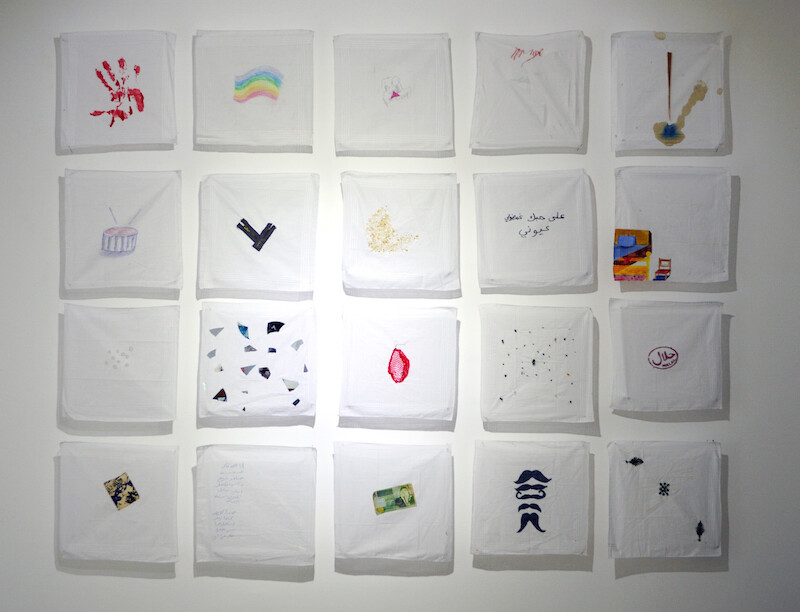The Electronic Intifada 1 September 2016

“Intimate Space X,” 2015, acrylic on canvas, 208 x 323 cm
A blue-black video shows the legs of a child as they half-dangle, half-jut off of a large block of gray limestone. Recorded at dusk, the child, a young girl, repeats for three minutes the phrase: iftah ijreik, sakr ijreik – open your legs, close your legs – as the light fades.
The child, clad in bright tights and bedazzled flip-flops, giggles. She has little idea what the game is about.
She grows bored, her legs stop moving, but a silent cue from off camera tells her to continue, so the words – iftah ijreik, sakr ijreik start up again.
Rana Samara’s crushingly simple video installation addresses the societal expectation that women and girls – at dizzying turns – be chaste, or available, at the command of others.
As the opening piece in her unflinching first solo exhibition Intimate Space – on show at Zawyeh Gallery, in the occupied West Bank city of Ramallah, through 10 September – the video makes evident why Samara is quickly becoming recognized as one of the strongest in a new generation of Palestinian artists.
Evidence of intimacy
Intimate Space is haunted by the sounds of the video installation, which follows viewers up the gallery stairs until Samara’s massive, technicolor canvases come into view. Each more than a meter and a half tall and up to three meters wide, the paintings portray life-sized scenes of bedrooms, balconies, kitchens, and taxi cabs, each a space of intimacy.
The canvases are narratives of sex: where it’s done and what’s left after. They reveal a Thursday evening ride-about in an off-duty taxi van (a prayer mat tossed over the dashboard, toilet paper scrunched up on a seat); an open-air balcony left with a sofa cover in disarray; in the kitchen, a tablecloth hastily thrown back where it belongs.

“Intimate Space XII,” 2016, acrylic on canvas, 163 x 303 cm
The details – what Samara calls the “evidence” of intimacy – are highlighted, foregrounded or appear oversized in proportion to the rest of the candid, often domestic, and always everyday spaces.
To notice these details is also to reconstruct what happened, putting the viewer in the position of detective or voyeur into these anonymous couples’ lives. Samara describes the spaces as akin to “crime scenes,” where an act was committed and its traces are visible if only one knows where to look.
Samara, a 31-year-old mother of three who was born in Jerusalem, began seriously pursuing art only after she had been married for several years.
In her artist statement for Intimate Space, Samara explains that “Women, gender and sexual relations comprise the backbone of my work; it all started after a walk in al-Amari refugee camp [near Ramallah], where I began wondering about the sex lives of couples living in such a condensed space that affords them almost no privacy.”
Collaboration with women
Undergirding her latest work, and appearing almost as research for the acrylic canvases, are a series of installations made in collaboration with women – many in al-Amari camp – Samara encountered as she thought through the Intimate Space project.
Three years before the paintings, Samara gave out used potholders to women in camps, villages and cities around the West Bank, and asked them to embroider the kitchen items with something – anything – that they desire.
On display are two of the results of the experiment. Potholders embellished with nearly invisible naked figures, embroidered in floss nearly the same color as the item. One, in green, shows a naked form from the waist down. On the other, bodies are in the midst of their own intimate encounters.
These subtle images embroidered by unnamed women on an item used daily in the preparation of food for the family provide a tactile contrast between women’s public roles and their private desires.

“Virginity Kerchiefs,” installation, 2013 (40 pcs, 35 x 35 cm each)
A second experiment provoked even richer results. Instead of potholders, both men and women were asked to draw, glue or stitch on a handkerchief. They were given the same sort of handkerchief laid down on a marriage bed to collect the blood of a new bride – shown as “evidence” of her “virginity” – and were asked to “express their opinion and understanding of this tradition.”
The images on the white squares – displayed all at once in four rows of five pin-mounted cloths – are damning: a Jordanian dinar, a shattered mirror, a factory-made halal stamp that might be found on a butcher’s window, Quranic suras on sex and women’s habits cut and pasted across the fabric, the phrase “your love closed my eyes” in embroidery floss, and a poem in pencil, questioning both the religious and cultural meaning of the use of the handkerchief and all it comes to symbolize.
Here too, the “evidence” of sex is turned around, taken out of its usual context, and forces questions about the parameters within which women’s sexuality is confined and made acceptable.
The handkerchiefs, like the belts curled up under couches, the underpants rumpled on the floor of a woman’s bedroom alongside a stuffed teddy bear seen in Samara’s paintings, put the existing rules into conflict with desire and sexual practice.
Within a context of conservatism and strict rules for women, which both women and men are meant to police, Samara brings the question of desire to the table by reminding her viewers that the table in question is, in fact, where intimacy has already taken place.
Images of artwork by Rana Samara courtesy of Zawyeh Gallery.
Nora Parr is Lecturer of English and Comparative Literature at Kings College London. She is a former Research Fellow at the Kenyon Institute in Jerusalem, obtained her PhD from the School of Oriental and African Studies, and is currently researching concepts of nation and trauma in Arabic literature.





